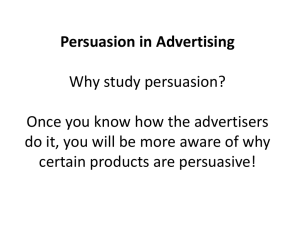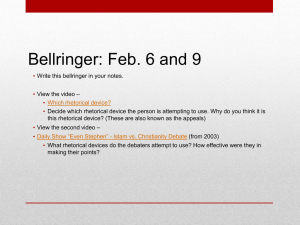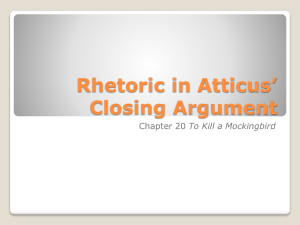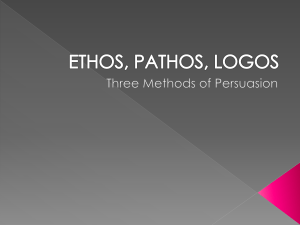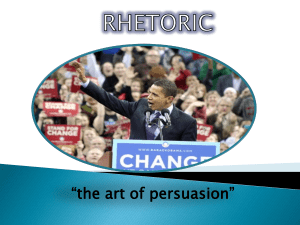Persuasion in Written Communication
advertisement
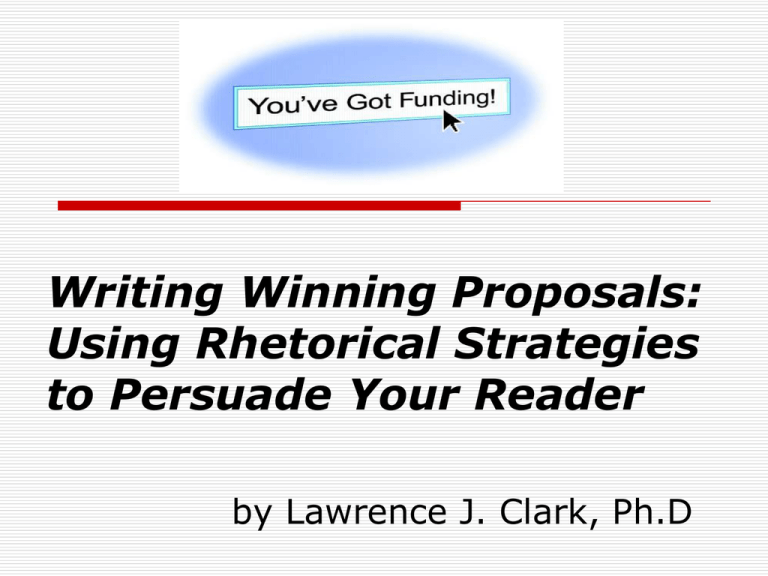
Writing Winning Proposals: Using Rhetorical Strategies to Persuade Your Reader by Lawrence J. Clark, Ph.D What We’ll Discuss Today Origin of rhetoric and Aristotle’s 3 “available means of persuasion” Writing Proposals: Considering the Rhetorical Situation Reader-Centered Writing Ethical and Unethical Uses of Language Part 1: Origin of rhetoric A loooooong time ago . . . When: 384-322 B.C. Where: Ancient Greece Who: Aristotle The Marketplace Aristotle observed interactions between people as they sold items, gave speeches, etc. wondered why some people were more successful than others in convincing people to buy their wares (action) or support their political views (belief). Taking Notes . . . Aristotle noted the different techniques that people used to convince or persuade others. narrowed down all their techniques down to three methods, which he called the “available means of persuasion.” Ethos Pathos Logos About the New Vocabulary . . . Don’t worry too much about the technical terms; focus on methods that YOU can use as you write grant proposals, fundraising letters, newsletters, give presentations, etc. SIDE NOTE: OTHERS use these strategies in writing or in speech to persuade, control, or manipulate you. Aristotle’s Means of Persuasion Ethos: perceived character or authority of the speaker Pathos: appealing to emotions Logos: appealing to logic or facts Ethos Using ethos is one way to persuade the listener or reader. If the writer or speaker is perceived by the listener to be authoritative or of good character, he or she will be believed. Example: Michael Jordan sells tennis shoes; he says, “Be like Mike and buy my shoes.” Kids look up to him and believe his shoes are good, so they buy them. This makes Mike very, very happy! Good Ethos #2 Example of Poor Ethos The “other” Michael World-renowned superstar Paid BIG MONEY for a 3-minute Pepsi commercial in 1984 Would you buy Pepsi from this man? Pathos Pathos is appealing to the emotions of the listener/reader. Example: You are reading a magazine and come across an advertisement for a children’s relief agency. You see a picture of a starving child, and the words, “for the cost of a cup of coffee a day you can feed this child.” This makes you feel guilty, so before heading to Starbuck’s for a $4.00 peppermint mocha latte, you get out your checkbook and send a donation! Other Pathos Examples Other emotions that can be played on include happiness, love, security, etc. Love and Happiness Sense of Well-Being Safety and Security Logos Some people are persuaded neither by the reputation or credentials of the speaker/writer, nor by the appeal to emotions. These people need facts or logic in order to be convinced. Criminal Investigators (Ma-am!) Scientists and Engineers 90 80 70 60 Example: Instead of the starving child and cup of coffee argument (pathos—emotional appeal), use a chart or graph with statistics about the poverty level in 3rd world countries and compare them to levels in the U.S. (logos— appeal to logic, use of facts and figures). 50 USA Europe 40 Indonesia 30 20 10 0 Income level Why is knowledge of rhetoric important? Whether you are reading a newspaper or watching TV or hearing a sales pitch, knowing about the effective use of ethos, pathos, and logos can help you to avoid falling prey to faulty or deceptive arguments. Also, when you are writing a grant application or giving a presentation, you can be sure to choose the appropriate method of persuasion based on who your audience is, and to be sure your arguments rest on solid ground. Part 2: Writing a Proposal: Considering the Rhetorical Situation Proposals are about Money and Power Who does what? For whom? For how much? For how long? Interpretation Use rhetorical strategies to Ask the right questions Impose mental structures on evolving, uncertain, or chaotic situations Assess and interpret the situation Do research, separate the wheat from the chaff (important vs. nonessential facts), then create a plan to solve the problem or manage the change Impose order on the situation Expression Expression is the performance side of rhetoric. First interpret the situation, then develop a rhetorical strategy to express your ideas and persuade others. Invent the content of the proposal Describe the current situation Set some goals Promote the plan The Rhetorical Situation Subject Purpose Audience Context Objectives Subject What is the proposal about? What is it not about? (scope) What is “inside” the box? What is “outside” the box? Decide what will stay in the box, and what you’ll need to put in the box (or leave out of it) in order for your readers to make an informed decision. Subject To determine subject, ask the three stasis questions: Is there a problem? What exactly is the problem? What type of problem is it? Boundaries (scope) What do my readers need to know? What don’t they need to know? Don’t frustrate the reader with non-relevant info! Purpose What outcome am I expecting? What do I want to achieve? Purpose After reading your proposal, what do you want the reader to: Do? Believe? To make this more clear in your mind (and eventually the reader’s mind) write out your purpose in ONE sentence. Write it on a a sticky note and stick it on your computer screen! Intended Audience (Reader or Listener) To whom will I address the proposal? Who will actually read it? Primary audience Secondary audience Audience Analyze your intended/potential audience/readers: Primary readers Person or people to whom the proposal is addressed Secondary readers Committee members, accountants, attorneys, etc. Tertiary readers Politicians, reporters, advocacy groups, hostile attorneys, etc. Gatekeepers Your supervisor, CEO, company attorney Audience Analyze your intended audience Generate ideas and use facts effectively to persuade your audience to accept your ideas Use facts, logic, emotion, and authority/credibility to persuade the reader (logos, pathos, and ethos) Use visual design to present your ideas in a professional package Context In what situation will the proposal be read? How will the context shape the reading/understanding/attitude toward the proposal? Objectives What are some other goals, besides the obvious purpose, that the proposal should achieve? Think about your readers’ Motives Profit Public perception “the right thing” Values Attitudes Emotions Context Physical Context Economic Context Ethical Context Political Context Objectives What else would you like your proposal to achieve? Achieve long term goals Change public’s perception of your organization, an issue, or a cause Affect greater community Aid society in some way Part 3: Reader-Centered Writing A means of delivering an easy to read document that clearly states its message How to Create a Reader-Centered Document Avoid “I” Focus on the reader’s needs, wants, and desires, not yours Choose Correct Words Use the correct word in the right place Use words in their proper context Understand the meaning of the word Consider your readers and write to their level Don’t use fancy words to impress the reader Getting the message across is more important than showing off your high-falootin’ vocabulary Example: most newspapers are written to a 5th grade level Use Plain English Avoid: Jargon Industry-specific language Technical terms Slang AGAIN: Know your readers and write to their level of understanding Sentence Structure Select words carefully Write clearly and concisely Avoid passive construction; use active voice NOT “the chocolate bar was eaten,” But, “My wife ate the chocolate.” This tells the reader not only WHAT was done, but WHO did it. Sentence Length Reduce wordiness Use 12 words instead of 20 to say the same thing Vary sentence length (long sentences are sometimes necessary to explain complex topics, but do your best to limit their use) List items in bullet points instead of paragraphs Avoid Errors—Proofread Religiously! Multiple errors make you or your organization look unprofessional, or worse, incompetent Print a draft—errors can be missed on screen Ask someone else to look it over—two (or three or four) heads are better than one! Ask for feedback Grammar, spelling, punctuation Clarity Does it send the right message? Part 4: Ethics in Persuasive Writing Ethical considerations of persuasion Logic fallacies Cause and effect (post hoc ergo propter hoc) Infers that because one thing follows another, it is a result of the first Drop in crime Longer life expectancy Personal attack (ad hominem) Kill the messenger You are a bad person, so your point is invalid Logical Fallacies (cont.) Bandwagon (ad populum) Appeal to popularity Everybody’s doing it, so you should, too! 90% of dentists recommend Crest 4 out of 5 would rather fight than switch Inference by association Guilt by association If a company makes one good (or bad) product, all their products are good (or bad) If some employees are bad or practice criminal behavior (Enron) the entire company is bad Other Persuasive Tactics Plain Folks I’m a regular Joe, so I wouldn’t lie to you Jimmy Dean sausage Old guy selling life insurance Testimonials Implies that the person supports the cause or uses the product Celebrity endorsements “Normal people” giving testimonies ( I lost 50 pounds!) Particularly effective for non-profit fundraising Transfer Uses positive symbols to transfer meaning to something else American flag Cross, Icthus (Christian fish symbol) Unethical Language Use: Language fallacies Equivocation Using one or both meanings of a word, then deliberately confusing the two in the audience’s mind Jar of spaghetti sauce (4 oz. “FREE”) Dan Rather will “resign” in March Amphiboly Using ambiguous sentence structure or grammar to mislead “New and Improved” “Helps prevent heart disease” Language Fallacies (cont.) Emotive language Using emotionally charged words to shift response from the argument itself to the images invoked by the words (similar to transfer) Freedom Miracle Powerful Younger looking Review Remember Aristotle’s three means of persuasion Ethos Pathos Logos Consider and analyze the rhetorical situation in which you are writing your proposal Do your best to use language persuasively, but ETHICALLY Now go write your WINNING PROPOSAL and get the money!
